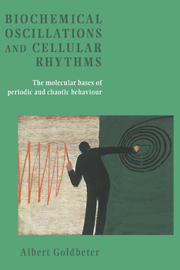Book contents
- Frontmatter
- Contents
- Foreword to the English edition by Michael Berridge
- Foreword to the French edition by Ilya Prigogin
- Preface
- 1 Introduction
- Part I Glycolytic oscillations
- Part II From simple to complex oscillatory behaviour
- 3 Birhythmicity: coexistence between two stable rhythms
- 4 From simple periodic behaviour to complex oscillations, including bursting and chaos
- Part III Oscillations of cAMP in Dictyostelium cells
- Part IV From cAMP signalling in Dictyostelium to pulsatile hormone secretion
- Part V Calcium oscillations
- Part VI The mitotic oscillator
- Part VII Circadian rhythms
- References
- Index
3 - Birhythmicity: coexistence between two stable rhythms
Published online by Cambridge University Press: 26 February 2010
- Frontmatter
- Contents
- Foreword to the English edition by Michael Berridge
- Foreword to the French edition by Ilya Prigogin
- Preface
- 1 Introduction
- Part I Glycolytic oscillations
- Part II From simple to complex oscillatory behaviour
- 3 Birhythmicity: coexistence between two stable rhythms
- 4 From simple periodic behaviour to complex oscillations, including bursting and chaos
- Part III Oscillations of cAMP in Dictyostelium cells
- Part IV From cAMP signalling in Dictyostelium to pulsatile hormone secretion
- Part V Calcium oscillations
- Part VI The mitotic oscillator
- Part VII Circadian rhythms
- References
- Index
Summary
A two-variable biochemical model for birhythmicity
Birhythmicity: coexistence of two stable limit cycles
The model governed by eqns (2.7) or (2.30) admits at most a single limit cycle, i.e. only one type of periodic behaviour for a given set of parameter values. The analysis of a three-variable model considered in chapter 4 has led to the fortuitous observation of a phenomenon of coexistence between two types of oscillation corresponding to two simultaneously stable limit cycles (Decroly & Goldbeter, 1982). This phenomenon represents a particular type of Instability, much less common than the one involving the coexistence between two simultaneously stable steady states, of which several examples are known in chemistry (Pacault et al, 1976; Epstein, 1984) as well as biochemistry (Degn, 1968; Naparstek et al, 1974; Eschrich et al, 1980, 1990), or that involving the coexistence between a stable steady state and a stable limit cycle; the latter phenomenon is known as hard excitation (Minorsky, 1962). To differentiate it from these two types of bistability, Decroly & Goldbeter (1982) coined the term birhythmicity to denote the coexistence between two simultaneously stable limit cycles.
Birhythmicity has not yet been clearly demonstrated in biological systems, although some observations suggest that this type of dynamic behaviour might occur in cardiac tissue (Mines, 1913; Gilmour et al, 1983) and in a neuronal preparation (Hounsgaard et al, 1988). Following the theoretical predictions of the phenomenon by the model analysed in chapter 4, an experimental study of a chemical system involving two coupled oscillatory reactions permitted the demonstration of a coexistence between two simultaneously stable periodic regimes (Alamgir & Epstein, 1983; Citri & Epstein, 1988).
- Type
- Chapter
- Information
- Biochemical Oscillations and Cellular RhythmsThe Molecular Bases of Periodic and Chaotic Behaviour, pp. 91 - 117Publisher: Cambridge University PressPrint publication year: 1996

